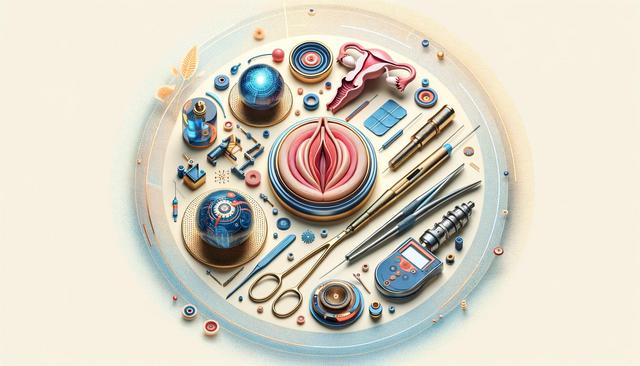Vaginal Restoration: Best Practices & Expert Tips
Explore key insights and expert recommendations for effective vaginal restoration practices.

Understanding Vaginal Restoration: What It Involves
Vaginal restoration refers to a range of non-surgical and surgical techniques aimed at improving vaginal health, function, and appearance. These procedures are often pursued for reasons such as post-childbirth recovery, aging-related changes, hormonal imbalances, or personal comfort. Common goals include enhancing vaginal elasticity, improving lubrication, addressing dryness, and restoring tissue tone. Vaginal restoration is a personal journey, and understanding your needs is the first step to identifying suitable options.
Some of the most commonly explored methods include:
- Laser-based therapies for collagen stimulation
- Radiofrequency treatments for tissue tightening
- Hormonal creams or suppositories
- Pelvic floor physical therapy
- Minimally invasive surgical procedures
Each of these methods has its own set of benefits and considerations. Consulting with a knowledgeable healthcare provider can help determine the most appropriate approach for your individual needs and medical history.
Non-Invasive Techniques for Vaginal Health
Many individuals prefer to start with non-invasive vaginal restoration options, especially those looking for gradual improvements without downtime. These procedures generally focus on stimulating natural tissue regeneration and improving moisture levels. Non-invasive therapies are often recommended for mild to moderate concerns and can offer significant benefits with consistent application over time.
Popular non-invasive techniques include:
- Laser therapy: Uses fractional laser energy to promote collagen production and improve tissue elasticity.
- Radiofrequency treatments: Deliver controlled heat to strengthen vaginal tissue and increase circulation.
- Topical estrogen creams: Help alleviate dryness and discomfort by balancing hormonal levels.
- Hyaluronic acid gels: Provide immediate relief from dryness and improve lubrication.
These methods are generally well-tolerated and require little to no recovery time. However, results may vary, and multiple sessions are often necessary to achieve desired outcomes. It’s essential to follow professional guidance and monitor progress through regular check-ins with your provider.
Pelvic Floor Rehabilitation and Lifestyle Adjustments
Strengthening the pelvic floor muscles plays a crucial role in vaginal restoration, particularly for those experiencing incontinence or a feeling of looseness. Pelvic floor therapy focuses on exercises and techniques designed to target and tone the underlying muscles that support vaginal and bladder function.
Effective pelvic floor rehabilitation may include:
- Kegel exercises: Repetitive contraction and relaxation of pelvic muscles to improve strength.
- Biofeedback therapy: Uses sensors to help patients learn how to control their pelvic muscles.
- Electrical stimulation: Gently stimulates the pelvic muscles to encourage muscle tone.
In addition to targeted therapy, lifestyle adjustments can also support vaginal health. Maintaining a balanced diet, staying hydrated, avoiding smoking, and managing body weight can contribute to better outcomes. Regular physical activity and stress management techniques may further enhance overall pelvic and vaginal wellness.
Hormonal Support and Natural Remedies
For many individuals, hormonal changes due to menopause, childbirth, or certain medical conditions can significantly impact vaginal health. Hormone therapy—when prescribed and monitored by a healthcare professional—can be an effective component of vaginal restoration. Estrogen therapy is commonly used to combat vaginal dryness, thinning, and discomfort.
In addition to hormone-based treatments, some prefer to explore natural remedies, which may support vaginal health alongside medical interventions. These include:
- Vitamin E suppositories: Known for their moisturizing and healing properties.
- Coconut oil: Often used as a natural lubricant.
- Probiotics: Help maintain a healthy vaginal microbiome.
- Plant-based phytoestrogens: Found in foods like soy and flaxseed, which may help balance hormones naturally.
Natural remedies should be approached with careful consideration, especially when used in conjunction with other treatments. Always discuss their use with a healthcare provider to ensure safety and effectiveness within your specific health context.
Choosing the Right Approach: Consultation and Follow-Up
When considering vaginal restoration, choosing the right approach involves more than selecting a treatment—it requires a comprehensive understanding of your goals, medical history, and lifestyle. A thorough consultation with a qualified provider is a critical first step. During this process, issues such as past surgeries, hormonal status, sexual health, and childbirth history will be reviewed.
Key considerations during consultation may include:
- Defining your restoration goals (comfort, appearance, function)
- Understanding the risks and benefits of each method
- Assessing any contraindications or medical conditions
- Creating a personalized treatment plan
Regular follow-up appointments are essential for monitoring progress and making adjustments to your treatment plan. Some methods require ongoing sessions or maintenance therapies to sustain results. Staying informed and engaged throughout the process can lead to more satisfying and lasting outcomes.
Conclusion: Supporting Long-Term Vaginal Wellness
Vaginal restoration is a deeply personal and empowering journey that combines medical knowledge, self-care, and professional guidance. Whether you opt for non-invasive therapies, hormonal support, or lifestyle adjustments, the goal is to improve both comfort and confidence. Prioritizing ongoing care, staying informed about options, and working with experienced professionals are key steps in supporting your long-term vaginal wellness. With the right approach, many individuals find renewed vitality and improved quality of life through thoughtful and consistent care.